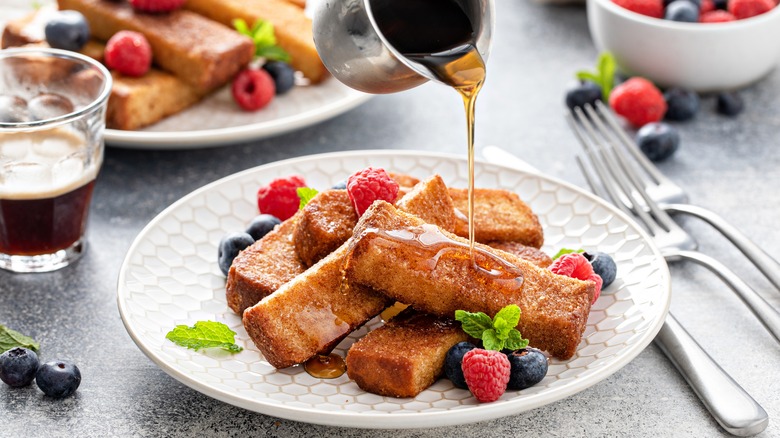Sugar Vs High Fructose Corn Syrup? Here's What A Nutritionist Has To Say
Sugar. It's in just about, well, everything. You might not see "sugar" on an ingredient label, but high fructose corn syrup can give that sweet taste to some of your favorite drinks and syrups. Is one better than the other? We asked certified dietician-nutritionist and nutrition specialist Francesca Alfano to give us a little more detail.
Table sugar, Alfano said, is made from glucose and fructose molecules and derived from sugar cane or beets. High fructose corn syrup is made from cornstarch by converting glucose into fructose. Sugar has equal parts glucose and fructose, while high fructose corn syrup can have up to 55% fructose.
Alfano added that our bodies metabolize these sweeteners differently. "When we consume sugar, our bodies break it down into glucose and fructose, which are then absorbed into the bloodstream and used for energy," Alfano said. "High fructose corn syrup, on the other hand, is absorbed more quickly and may cause a larger spike in blood sugar levels."
Because the liver primarily metabolizes fructose, too much of it can get converted into fat. This can result in insulin resistance, fatty liver disease, and other health problems, Alfano said.
Sneaky places you'll find sugar and high fructose corn syrup
Alfano said that a lot of food you might typically buy has sugar and high fructose corn syrup, so it's best to check the labels of most foods. Your favorite strawberry-flavored yogurt could have up to 20 grams of sugar per serving, which is like adding five teaspoons of sugar to your small cup. Granola bars and sports drinks are also typically marketed to be healthy options to candy and soda, but they can have about 20 grams of sugar per serving as well.
Your favorite healthy smoothie could also be loaded with sugar. "This is because some will have added fruit juice, frozen yogurt, or sweetened nut milks, which can all add to the sugar content," Alfano said.
Even condiments have added sugar and high fructose corn syrup to help with the taste. Salad dressings can have 10 grams of sugar per serving, and a tablespoon of ketchup can add 4 grams of sugar to your diet. Some condiments can add up to 10 grams of high fructose corn syrup per serving.
High fructose corn syrup can also be found in some breakfast cereals, breads, and crackers. Even drinks like V8 and Minute Maid will add high fructose corn syrup to their mix. It's also best to check the list of ingredients in many jams and jellies because some brands will add up to 9 grams of high fructose corn syrup to make them taste sweeter.
Which is worse for you — sugar or high fructose corn syrup?
Alfano said that high fructose corn syrup is much cheaper to produce than table sugar, so that's why it's so widespread in many processed foods. High fructose corn syrup has also been linked with increases in obesity, diabetes, cardiovascular disease, and metabolic syndrome. Alfano cautioned that many of these studies have been correlational and can't imply causation. She added that high fructose corn syrup that's used in many foods today is nearly equivalent to table sugar and honey in terms of levels of fructose. She further pointed out a 2007 study in Nutrition that found no differences between table sugar and high fructose corn syrup in fasting glucose, insulin, leptin, and ghrelin in a small, short-term study on lean women.
"Overall, it's important to remember that both sugar and high fructose corn syrup are added sugars that should be consumed in moderation as part of a healthy diet," Alfano said. "It's always a good idea to read food labels and choose products that are lower in added sugars."



